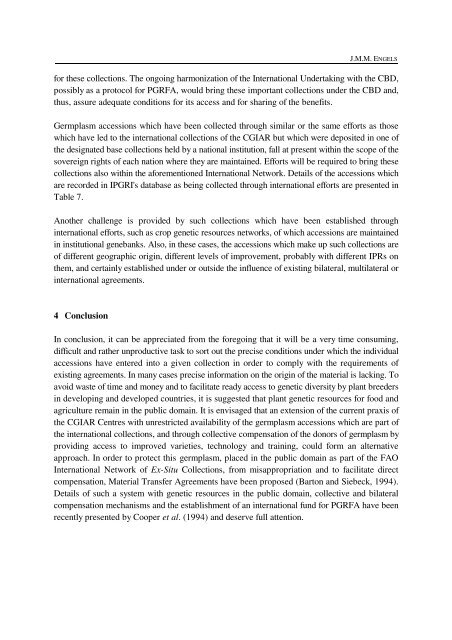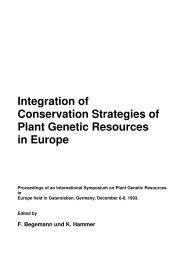Zugang zu Pflanzengenetischen Ressourcen für die ... - Genres
Zugang zu Pflanzengenetischen Ressourcen für die ... - Genres
Zugang zu Pflanzengenetischen Ressourcen für die ... - Genres
Erfolgreiche ePaper selbst erstellen
Machen Sie aus Ihren PDF Publikationen ein blätterbares Flipbook mit unserer einzigartigen Google optimierten e-Paper Software.
J.M.M. ENGELS<br />
for these collections. The ongoing harmonization of the International Undertaking with the CBD,<br />
possibly as a protocol for PGRFA, would bring these important collections under the CBD and,<br />
thus, assure adequate conditions for its access and for sharing of the benefits.<br />
Germplasm accessions which have been collected through similar or the same efforts as those<br />
which have led to the international collections of the CGIAR but which were deposited in one of<br />
the designated base collections held by a national institution, fall at present within the scope of the<br />
sovereign rights of each nation where they are maintained. Efforts will be required to bring these<br />
collections also within the aforementioned International Network. Details of the accessions which<br />
are recorded in IPGRI's database as being collected through international efforts are presented in<br />
Table 7.<br />
Another challenge is provided by such collections which have been established through<br />
international efforts, such as crop genetic resources networks, of which accessions are maintained<br />
in institutional genebanks. Also, in these cases, the accessions which make up such collections are<br />
of different geographic origin, different levels of improvement, probably with different IPRs on<br />
them, and certainly established under or outside the influence of existing bilateral, multilateral or<br />
international agreements.<br />
4 Conclusion<br />
In conclusion, it can be appreciated from the foregoing that it will be a very time consuming,<br />
difficult and rather unproductive task to sort out the precise conditions under which the individual<br />
accessions have entered into a given collection in order to comply with the requirements of<br />
existing agreements. In many cases precise information on the origin of the material is lacking. To<br />
avoid waste of time and money and to facilitate ready access to genetic diversity by plant breeders<br />
in developing and developed countries, it is suggested that plant genetic resources for food and<br />
agriculture remain in the public domain. It is envisaged that an extension of the current praxis of<br />
the CGIAR Centres with unrestricted availability of the germplasm accessions which are part of<br />
the international collections, and through collective compensation of the donors of germplasm by<br />
providing access to improved varieties, technology and training, could form an alternative<br />
approach. In order to protect this germplasm, placed in the public domain as part of the FAO<br />
International Network of Ex-Situ Collections, from misappropriation and to facilitate direct<br />
compensation, Material Transfer Agreements have been proposed (Barton and Siebeck, 1994).<br />
Details of such a system with genetic resources in the public domain, collective and bilateral<br />
compensation mechanisms and the establishment of an international fund for PGRFA have been<br />
recently presented by Cooper et al. (1994) and deserve full attention.










